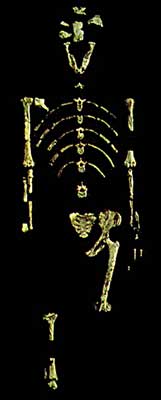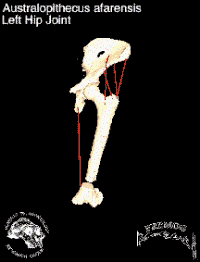2a. "I Love Lucy"

Lucy is an Australopithecus afarensis. This fossil was discovered by Donald Johanson and Tom Gray in 1974 at Hadar in Ethiopia. It is estimated to be 3.2 million years old.
Singer Elton John is connected to our original, ancient ancestors. In 1974, his cover of the Beatles hit "Lucy in the Sky with Diamonds," echoed throughout the night in the barren landscape of Hadar, Ethiopia.
Paleoanthropologist Donald Johanson and his team were blasting this song on their cassette player inside their work tent. (A paleoanthropologist studies fossil hominids.) They were celebrating the discovery of the oldest known hominid ancestor. Inspired by the song, the team named the partial skeleton, "Lucy."
Lucy was a newly discovered species named Australopithecus afarensis and lived 3.5 million years ago. Many scientists came to regard her as the mother of humankind. Who was Lucy? What was life like for her?
A more pressing question: What was Lucy? She had both ape and human characteristics. Which was she? She is actually related to both humans and apes.
Based on the partial skeleton that he assembled, Johanson concluded that Lucy had a receding forehead and prominent face, much like an ape. Her softball-sized brain was a little larger than a chimpanzee's, yet much smaller than a modern human's. Her dark skin and patchy hair protected her from the sun of tropical Africa. The lush, green environment near the Awash River seemed to be her home and this region was one of the few areas in which apes could live.
Yet Lucy's knee joint looked vaguely human. This joint was capable of locking straight up. Unlike the quadrupedal ape (which walked on all fours), Lucy seemed to be a bipedal (able to walk on two legs) with the capability of walking erect over long distances. She was thus able to travel in search of food.

Lucy's bone structure allowed her to move in similar ways to modern-day humans.
Over thousands of years, Lucy and her ancestors physically adapted to their changing natural environment. Open grasslands replaced the shrinking dense forests of the Great Rift Valley. Since Lucy walked upright, she could stroll across the grasslands from forest to forest and use her free hands to gather food. This was a major development. Lucy's diet consisted of fruit, small animals (such as field mice), bird eggs, and even insects. Archaeologists believe Lucy was able to extract termites from their mounds using a blade of grass. This is an important capability because it demonstrates that Lucy, and others like her, were developing a more advanced use of their hands. And that ability brings Lucy a step closer to us — humans.
Lucy: In a Class by Herself
Lucy belonged to genus Australopithecus and the species afarensis, but she also belonged to the the hominid family (hominidae) to which humans belong. Although humans are of the family hominidae, we are not of Lucy's genus or species. We are Homo sapiens. How then, can Lucy be our ancient ancestor if we belong to a different genus and species? It's because humans and Lucy share a taxonomy up to the point of genus and species; there are many shared characteristics, but there are differences and these differences place humans in our own genus and species.
What Is a Taxonomy?
| Taxonomic Category | Human Taxonomy | Defining Features |
| Kingdom | Animalia | Humans are animals — not plants |
| Phylum | Chordata | Chordates have nerve fibers running along the midline of the back |
| Subphylum | Vertebrata | Vertebrates have internal, segmented spinal columns. The right side of the vertebrate mirrors the left side. |
| Class | Mammalia | Mammals have hair, mammary glands, and a constant internal temperature. They nurture their offspring after birth. |
| Order | Primates | Primates have specialized structures in the ear region and an enhanced blood supply to the brain. |
| Suborder | Anthropoidea | Anthropoids are social animals that are active in the daylight. |
| Superfamily | Hominoidea | Hominoids have similar back teeth, shoulder muscles and bones. Hominoids do not have tails. |
| Family | Hominids | Hominids walk on two feet. |
| Genus Species | Homo sapiens | Homo sapiens share characteristics in the details of brain and tooth size. |
Humans and apes are both in the Hominid family. As hominids, we share many physical similarities in bones, back teeth and shoulder muscles. Neither the apes nor the humans have tails and we all walk on two feet .
Now take Lucy. She is a hominid because she was bipedal, but she was of the genus species Australopithecus afarensis. Australopithecus represents her genus name (which is always capitalized), and afarensis, is the species name (which is always in lower case). So, while Lucy and modern humans share some traits like the ability to walk upright, there are too many structural differences to classify us in the same genus.
The species is generally the smallest working unit in the classification of plants and animals. Lucy differed from the humans in both genus and species. We modern humans share some closer relatives that share our genus, Homo, but not our species, sapiens.
The Homo habilis lived about two million years ago. Like modern humans, they belong to the genus Homo which derives from the Latin word for "man." But they are of the species habilis, not sapiens. Homo habilis translates as handy man. Homo sapiens translates as "wise man." While the two species share many traits in common including similarities in skull and jaw shapes and the ability to make tools, there are also things that are different both physically and genetically. We've grown a lot along the way.







